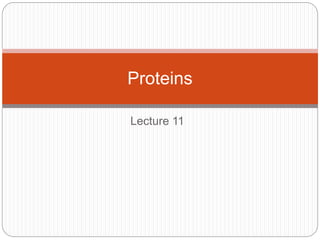
Proteins lecture 11
- 2. Physical properties of amino acids 1. Solubility: Most of the amino acids are usually soluble in water and insoluble in organic solvents 2. Melting point: Generally melt at higher temperature often above 200o C 3. Taste: They may be sweet , tasteless or bitter
- 3. 4. Optical properties: All the amino acids except glycine posses optical isomers due to the presence of asymmetric carbon atom 5. Amino acids as ampholytes Amino acids contain both acidic (-COOH) and basic (-NH2) groups. The can donate and accept a proton Zwitterion or dipolar ion
- 4. Chemical properties The general reactions of amino acids are mostly due to the presence of two functional groups Carboxyl group Amino group
- 5. Reactions due to –COOH group 1. Amino acids form salts with bases and esters with alcohol 2. Amino acids undergo decarboxylation producing corresponding amines (histamine, tyramine) 3. The carboxyl group of dicarboxylic amino acids reacts with ammonia to form amide Aspartic acid + NH3 Asparagine Glutamic acid + NH3 glutamine
- 6. Reactions due to –NH2 group 1. The amino groups behave as bases and combine with acids to form salt 2. The amino acids react with ninhydrin to form a purple, blue or pink colour complex (Ruhemann’s purple) 3. Colour reaction of amino acids: amino acids can be identified by specific colour reactions 4. Transamination 5. Oxidative deamination
- 7. Non-standard amino acids Amino acid derivatives in proteins e.g. Collagen, Histone, cystine Non-protein amino acids They may be either alpha or non alpha amino acids e.g. Ornithine, Citrulline, thyroxine D-amino acids The vast majority of aa isolated from animals and plants are of L-category. Certain D-amino acids are found in the antibiotics. D-alanine and D-glutamic acid are found in bacterial cell wall D-serine and D-aspartate are found in brain tissues
- 8. Structure of Proteins The structure of proteins can be divided into four levels of organization 1. Primary structure 2. Secondary structure 3. Tertiary structure 4. Quaternary structure
- 9. Primary structure of proteins Each protein has a unique sequence of amino acids which is determined by the genes contained in a DNA. The primary structure is largely responsible for its function A vast majority of genetic disorders are due to abnormalities in the primary structure of proteins Peptide bond Characteristics of peptide bonds The peptide bond is rigid and planar with partial double bond in character. Both –C=O and –NH groups of peptide bonds are polar and are involved in hydrogen bond formation
- 10. Writing of peptide structures: Conventionally the peptide chains are written with the free amino end (N-terminal) at the left and the free carboxyl end (C-terminal) at the right. The amino acid sequence is read from N-terminal end to C-terminal end The protein synthesis also starts from the N- terminal amino acid
- 11. Shorthand to read peptides: The amino acids in a peptide or proteins are represented by the 3-letter or one letter abbreviation. This is chemical shorthand to write proteins Naming of peptides: The suffixes –ine, -an, -ate are changed to –yl with the exception of C-terminal amino acid H3N-glutamate-cysteine-glycine-COO- E C G Glu Cys Gly Glutamyl Cysteinyl Glycine
- 12. Secondary structure of Protein The conformation of polypeptide chain by twisting or folding is referred to as secondary structure The amino acids are located close to each other in their sequence Two types of secondary structures, alpha helix an beta sheet are mainly identified Indian scientist Ramachandran made a significant contribution in understanding the spatial arrangement of polypeptide chains
- 13. Alpha helix α-helix is the most common spiral structure or proteins. It has a rigid arrangement of polypeptide chain α-helical structure was proposed by Pauling and Corey (1951)
- 15. Salient features 1. the alpha helix is tightly packed coiled structure with amino acid side chains extending outwards from the central axis The alpha helix is stabilized by extensive hydrogen bonding. It is formed between H atom attached to peptide N, and O atom attached to peptide C. the hydrogen bonds are individually weak but collectively they are strong enough to stabilize the helix All the peptide bonds except the first and last in polypeptide chain participate in hydrogen bonding
- 16. Each turn of alpha helix contains 3.6 amino acids and travel a distance of 0.54 nm. The spacing of each amino acid is 0.15 nm Alpha helix is a stable conformation formed spontaneously with the lowest energy The right handed helix is more stable than the left handed helix Certain amino acids disrupt the alpha helix (proline, basic and acidic amino acids)
- 17. Beta pleated sheets They are composed of two or more segments of fully extended peptide chains In the beta sheets the hydrogen bonds are formed between the neighboring segments of polypeptide chains
- 21. Tertiary structure The three dimensional arrangement of protein structure is referred to as tertiary structure. It is a compact structure with hydrophobic side chains held interior while the hydrophilic group on the surface of protein molecule Besides the hydrogen bond, disulphide bond, ionic interaction, hydrophobic interactions and Vander wall forces also contribute to the tertiary structure of proteins
- 23. Quaternary structure A great majority of proteins are composed of single polypeptide chains Some of the proteins however consists of two or more polypeptides which may be identical or unrelated. Such proteins are termed as oligomers and possess quaternary structure The individual polypeptide chains are known as monomers, protomers or subunits A dimer consists of two polypeptide chains while tetramer has four
- 24. Bonds The monomeric subunits are held together by non covalent bonds namely hydrogen bonds, ionic bonds
- 25. Importance These proteins play a significant role in the regulation of metabolism and cellular functions Examples Hemoglobin, aspartate tanscarbomylase, lactate dehydrogenase.